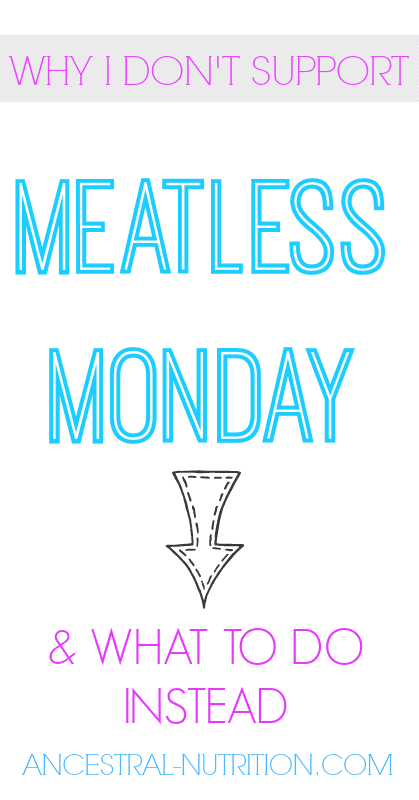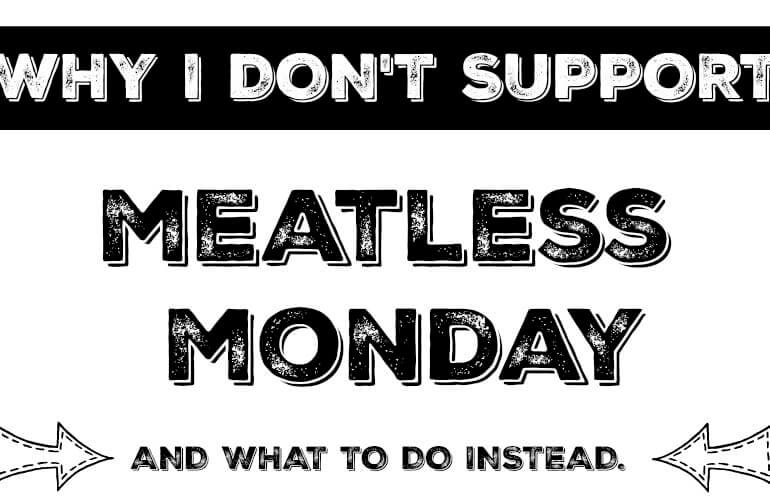Plant-based diets for environmental protection are too short-sighted. They aren’t effective.
No issue as big as environmental destruction is black and white, and going meatless one day a week is not a step in the right direction. Why is there no emphasis on organic, local and sustainable food? Why do the Meatless Monday recipes promote refined carbohydrates, inorganic tofu with no emphasis on GMO-free, low-fat dairy (which is extremely unhealthy) and refined vegetable oils?
Today I’m going to wade through the BS claims that the Meatless Monday foundation makes, and provide a more sustainable and healthy alternative.
LIMIT CANCER RISK: Hundreds of studies suggest that diets high in fruits and vegetables may reduce cancer risk. Colon cancer is associated with red and processed meat consumption.
What are these mysterious hundreds of studies? Where are they?
Because there are absolutely no links to support this very broad claim on the Meatless Monday website. Of course a diet rich in (organic, local) proceed will reduce cancer risk. I’m not arguing that. But that red meat consumption is associated with cancer of any kind? This is a lie.
There is no study in existence that proves that red meat consumption, particularly from pastured animals, increases cancer risk (or risk of any other disease). Furthermore, these studies are often flawed. Who funds them? Was the person eating hot dogs or grass-fed beef and veggies? Were they a smoker? A drinker? Did they exercise?
There are too many factors when it comes to these types of studies. The studies I prefer to rely on are based on history. There are several cultures that eat red meat frequently, like the Masai, the Eskimo, the Maori, the Muhima Tribe in Uganda and so many more. We have evolved eating meat, it is in fact what allowed us to evolve. There is a reason that our ancestors didn’t die of heart disease, cancer, diabetes or obesity, and it ain’t because they participated in meatless anything.
Traditionally, our ancestors knew the value of animals.
Organ meats, fish eggs, oysters, these were all considered sacred foods; and rightfully so, they’re the most nutrient-dense foods on the planet. And guess what? None of the cultures were at risk for cancer of any kind.
REDUCE HEART DISEASE: Recent data from a Harvard University study found that replacing saturated fat-rich foods (for example, meat and full-fat dairy) with foods that are rich in polyunsaturated fat (for example, vegetable oils, nuts, and seeds) reduces the risk of heart disease by 19%. and LIVE LONGER: Red and processed meat consumption are associated with increases in total mortality, cancer mortality and cardiovascular disease mortality. From Harvard,
Well it’s time to end the low-fat myth. The low-fat approach to eating may have made a difference for the occasional individual, but as a nation it hasn’t helped us control weight or become healthier. In the 1960s, fats and oils supplied Americans with about 45 percent of calories; (1) about 13 percent of adults were obese and under 1 percent had type 2 diabetes, a serious weight-related condition. (2,3) Today, Americans take in less fat, getting about 33 percent of calories from fats and oils; (4) yet 34 percent of adults are obese and 11 percent have diabetes, most with type 2 diabetes.
I’ll give you one guess as to the type of fat people were eating in the ’60s: saturated.
The backward nature of fat consumption in this country is astounding. We know that margarine is unhealthy, but do you know why? In addition to being a highly refined food product, it is rich in the type of fat we need to avoid: polyunsaturated fat.
PUFAs are extremely high in the inflammatory omega-6 fatty acid, which causes everything from heart disease to cancer. This is because at the base of all disease lies inflammation, so when inflammatory foods are regularly consumed, the body eventually creates disease.
The vilification of saturated fat is not only outdated but entirely misguided.
Our ancestors and traditional cultures have always eaten saturated fat. Why didn’t they get heart disease? Why weren’t they obese? Because saturated fat is healthy, it protects against heart disease. Saturated fat intake has little impact on the cholesterol found in blood; the body produces cholesterol on its own. We would literally die without cholesterol.
About half of our cell membranes are made up of saturated fat, so how could it be so unhealthy? The answer is that it isn’t. Polyunsaturated fats, vegetable fats, in particular, are unhealthy. Not only do they contain oxidized cholesterol, they are extremely inflammatory. These are the fats that cause heart disease and obesity.
The Meatless Monday campaign encourages vegetable oils? REALLY?
Let’s explore that a little more. Common vegetable oils include soy oil, corn oil, canola oil and cottonseed oil. These are the most genetically modified crops in the US. GMOs not only destroy the environment, they have been linked to infertility, cancer, aggression, as well as the brain, heart, and intestinal defects.
IMPROVE YOUR DIET.
Consuming beans or peas results in higher intakes of fiber, protein, folate, zinc, iron, and magnesium with lower intakes of saturated fat and total fat.
The problem with legumes, like beans, is that they are high in phytic acid. Phytic acid binds with minerals like zinc, iron, and magnesium, preventing them from being absorbed. So while beans may have a decent amount of minerals, the amount that is absorbed from them is no way a reflection of the actual mineral content. Let’s take a look at the nutrient profile of beans versus a steak:
| Black Beans (100 g) | Steak (100 g) | |
| Fat | 0.54 | 2.69 |
| Protein | 8.86 | 23.07 |
| Carbohydrate | 23.71 | 0 |
| Calcium | 27 | 9 |
| Iron | 2.10 (non-heme) | 1.85 |
| Magnesium | 70 | 23 |
| Potassium | 355 | 342 |
| Zinc | 1.12 | 3.61 |
| Folate | 149 | 13 |
| Vitamin B12 | 0 | 1.27 |
| Vitamin D | 0 | 13 |
While the beans appear to be higher for some nutrient stats, you again have to consider what is being absorbed.
With the high amount of phytic acid, it’s not much. Coupled with the fact that beans are high in carbohydrate and relatively low in protein, especially when compared to steak, beans are hardly a dietary improvement.
REDUCE YOUR CARBON FOOTPRINT.
The United Nations’ Food and Agriculture Organization estimates the meat industry generates nearly one-fifth of the man-made greenhouse gas emissions that are accelerating climate change worldwide . . . far more than transportation. And annual worldwide demand for meat continues to grow. Reining in meat consumption once a week can help slow this trend.
and
MINIMIZE WATER USAGE.
The water needs of livestock are tremendous, far above those of vegetables or grains. An estimated 1,800 to 2,500 gallons of water go into a single pound of beef. Soy tofu produced in California requires 220 gallons of water per pound.
and
HELP REDUCE FOSSIL FUEL DEPENDENCE.
On average, about 40 calories of fossil fuel energy go into every calorie of feed lot beef in the U.S. Compare this to the 2.2 calories of fossil fuel energy needed to produce one calorie of plant-based protein. Moderating meat consumption is a great way to cut fossil fuel demand.
These figures are based on Concentrated Animal Feeding Operations, not small, local, sustainable farms that practice pasture-based farming. So, what are the figures for agriculture, for these mono-crops, for this entirely new way of farming we’ve enacted?
“As of now, it takes more than a calorie of fossil fuel to produce a calorie of food energy for humans—somewhere between four and ten calories of fossil fuel for a calorie of food. The fossil fuel is in both the fertilizer and the pesticides, and it’s essential to the machinery needed to plant, harvest, process, and transport grain. All told, an acre of corn drinks about fifty gallons of oil.”
Meatless Monday neglects to address the fact that wheat, legumes, soy, rice, canola, and corn (staples of vegetarianism) destroy topsoil. Several of these crops are genetically modified.
We have removed animals from the equation, and we are suffering for it. The land needs animals, and the animals need the land. The soil is hungry, and it needs to be fed the manure of cattle, not the pesticides we are dumping on it.
This is the fatal flaw of giving up meat, the earth needs the animals. It is a relationship that is mutually beneficial. Cattle should be in the pasture, not in feedlots. And we need to support pasture-based farms, not avoid them. When you consider the amount of energy and resources that go into growing grain and legumes, the water, the fossil fuel, the transportation for shipping foods that don’t naturally grow in many parts of the US, it quickly becomes much less sustainable than pasture-based farms.
I don’t deny that CAFO animals are not only harmful to the environment but also abused.
Don’t blame the cow, blame the food system.
“If we took 75% of the world’s trashed rangeland, we could restore it from agriculture back to functioning prairies — with their animal cohorts — in under fifteen years. We could further sequester all of the carbon that has been released since the beginning of the industrial age. So I find that a hopeful thing because, frankly, we just have to get out of the way. Nature will do the work for us. This planet wants to be grassland and forest. It does not want to be an agricultural mono-crop.”
Let me blow your mind real quick:
We can heal the land by the very thing Meatless Monday shuns: cattle.
Allan Savory, founder of The Savory Institute has successfully reversed desertification through Holistic Management. Please take the three minutes and twenty-five seconds to watch this introduction to Holistic Management:
And here’s an example of a pasture-based farm that not only treats their animals well, but builds topsoil, makes effective use of their land and animals, and explains how a farming model like theirs is not only environmentally friendly but can change the world:
Here’s what I propose: switching from Meatless Monday to Sustainable Monday.
I know, it doesn’t have the alliteration going for it, but it’s a step in the right direction. Instead of cutting out meat, which does virtually nothing for the individual or the environment, let’s focus on local food, on sustainable food. Buy pastured beef, chickens and eggs. Buy raw milk. Support a farmer, not a corporation.
Because every single time you purchase food, you vote. You can vote for local, sustainable farms. Or you can vote for GMOs, for giant corporations, for Meatless Monday.
If you aren’t sure where to start with a sustainable, organic, real food diet, you can use coupon code 20off to get 20% off my program, The 21 Day Lifestyle Transformation.
It contains meal plans with daily directions to overhaul your diet. In addition, it contains guides to finding locally, sustainably raised food across the US and how to successfully grocery shop while avoiding GMOs.

Sources:
http://www.hsph.harvard.edu/nutritionsource/fats-full-story/#Intro
https://ancestral-nutrition.com/top-10-gmos/
Nutrition and Physical Degeneration
http://ndb.nal.usda.gov/ndb/foods/show/4737
http://ndb.nal.usda.gov/ndb/foods/show/3782





